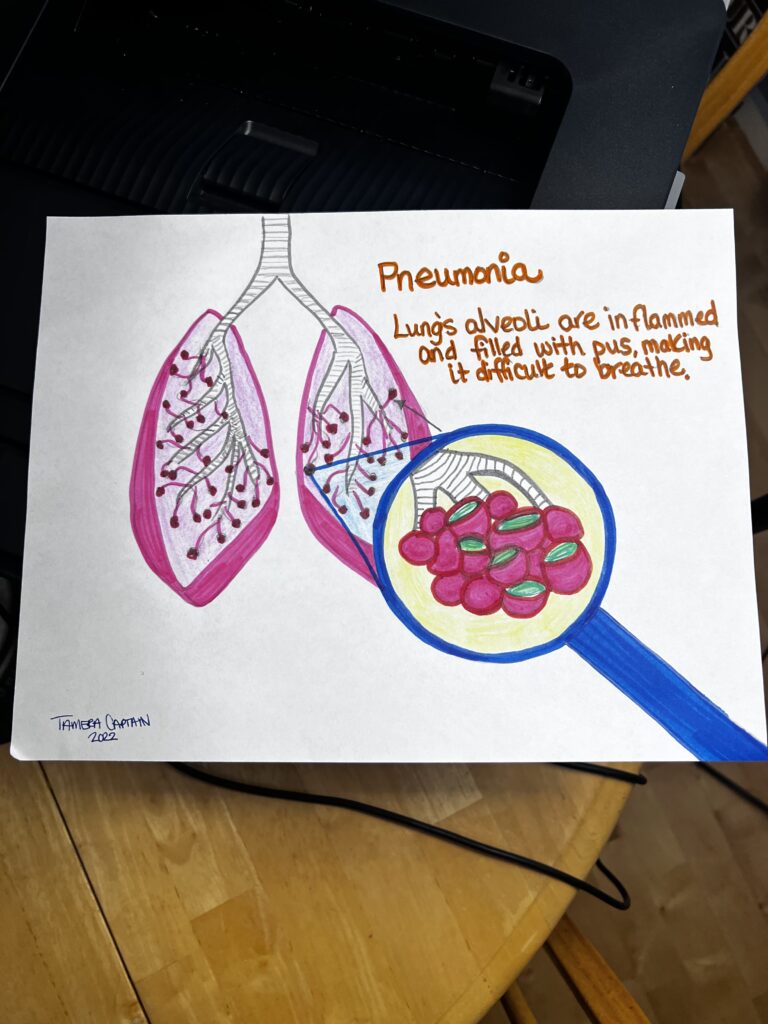Effects to the lungs from Pneumonia
My STEAM project will be about the effects pneumonia has on your lungs. Weird question but have you ever imagined putting one of those thin plastic grocery store bags over your head just to be curious on how it would feel to not be able to breathe? Sounds scary I know, but this is a perfect way to show you the effects of pneumonia has the lungs. So, imagine that your head is the lung, and the plastic bag is your body and skin. The longer untreated, the less air you have in the grocery bag. If that isn’t bad enough, not only do you run out of air, but liquid is also now being poured into bag. Not only are you gasping for air you are also drowning. Then of course we all know what happens if left untreated, death. Well enough with that, lets get into some actual, scientifically proven facts on the effects pneumonia has on the lungs. Some of the facts will include how to get pneumonia and what it is, what’s happening in the lungs while pneumonia is forming(symptoms), what happens if untreated and treated (medications), long-lasting effects on lung tissues.
I have learned that it’s an infection caused by bacteria or virus and fungi. According to the Mayo clinic (Pneumonia – Symptoms and causes – Mayo Clinic (www.mayoclinic.org) , fungal pneumonia is not infectious. Depending on factors such as the type of germ causing the infection the symptoms may be mild or severe, and your age and overall health are also major concerns. The signs and symptoms of pneumonia may be chest pain, coughing, confusion, phlegm buildup, fatigue, fever, sweating and shaking chills, nausea, vomiting, and shortness of breath.
A great majority of lung scarring cases may be caused by pneumonia, according to the University of Maryland Medical Center ( What Causes Scarring of the Lungs? (healthfully.com) ). While you have pneumonia there is damage to the bronchi and two major airways to the lungs. The alveoli and the small air sacs can be affected by lifestyle, disease, and environmental factors, which can lead to scarring of the lungs.
Here are some ways to treat viral pneumonia according to this type is caused by the viruses that also cause the common cold or flu. So, this specific type typically goes away on its own with enough time and rest. Antibiotics for Pneumonia: Types, How Long You’ll Take Them (verywellhealth.com) One of the best ways to prevent bacterial pneumonia is having the vaccination. There are currently four vaccines available in the U.S. they are: PCV13, PCV15, PCV20, and PPSV23. They are to help protect against a number of bacteria that cause pneumonia and other pneumococcal diseases. There is also an antibiotic called amoxicillin but the ones who can’t take penicillin will be prescribed cephalosporin like Rocephin.
Now the question we have all been waiting for… What happens if you have pneumonia, and you also contract Covid-19? Let’s check the media, one study from 2021 found that people with a history of pneumonia have an increased risk of death from COVID-19. This goes out to the ones that range from the ages 55–85. The Centers for Disease Control and Prevention (CDC) has confirmed that COVID-19 increases with age, and people over age 65 are at the highest risk. This means it is important for people who are older to reduce their risk of exposure to coronavirus and avoid developing pneumonia secondary to COVID-19.( Pneumonia and COVID-19: Risks, Safety Considerations (verywellhealth.com))
So that wraps up my project, thanks


For Tamera’s STEAM Project, she decided to focus on the effects of pneumonia on the lungs. The focus of the project and course objective she explored further on is “analyze the effects of disease on function and structure of the respiratory system” from Unit 12: Respiratory System. Her project is an illustration which demonstrations the lungs being afflicted with pneumonia and where the root issue is introduced, within the alveoli. In her depiction she is showcasing a pair of lungs that are infected with pneumonia and highlights with a magnifying glass, the inflamed alveoli whilst explaining how the alveoli inflammation can scar the lungs and lead to significant damage that will create the difficulty for the inflicted person to breathe. Within her essay, she discusses how the lungs are affected, the causes from bacteria and infection, and treatment options based on the types of viral and bacterial pneumonia, as well as includes the risk factors for contracting COVID-19 for those who have has a history of contracting pneumonia. She also discusses the different risk factors that come from certain lifestyle choices and environmental factors that contribute to the range in impact the pneumonia will have, from painful symptoms to death if left untreated.